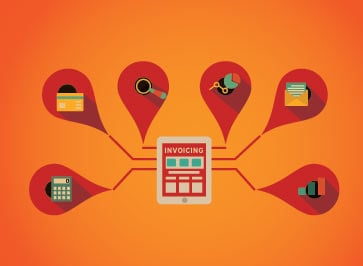Invoicing technology is becoming more customisable, writes Matthew Shanahan.

Matt Shanahan, Globys
In the early ‘90s, the only street map available to consumers was a massive, unwieldy multi-fold paper generated by old-school cartographers and geomatics engineers. It certainly wasn’t an interactive experience, unless you count the numerous hours lost figuring out how to fold the map back into its original dimensions. Technically you could scribble notations on it or ask a passerby to also view the paper – but that would be the only way to actually interact with a map in that era. 1993 brought the debut of services like the Xerox PARC Map Viewer, which began the transition to a digital age. But even those services were limited, and often static.
Fast forward to present day, where Google Maps presents a mind-boggling amount of interactive features. Not only can you look up simple street mapping, but you can perform every imaginable tangent task. You can perform calculations of area, distance, currency, transportation fares. You can drill down on every conceivable data point imaginable, act on those data points, perform e-Commerce activities, and share your findings with others. For consumers, Google Maps is pretty much one step away from magic.
INTO THE DIGITAL AGE
The history of invoicing is oddly similar. Electronic Bill Presentment and Payment (EBPP) systems were attempted in the late 1990s as a way to transition to the digital age, but these fell woefully short for enterprise needs. There simply wasn’t any interactivity, unless – similar to map interactivity – you counted scribbling on it or asking a co-worker to also view the paper. You definitely couldn’t perform any calculations digitally. It was impossible to drill down on any data points at all. There were no transactions you could perform, and sharing with others meant printing or emailing a copy.
“The modern day invoice will be the critical last mile of the customer experience”
Fast forward to present day, where B2B invoicing has improved exponentially with a pragmatic mélange of digital invoicing tools and features that shed the document paradigm. What used to be a static image or a PDF has now blossomed into interactive functions that allow a variety of accounts payable or line of business managers to more easily perform their duties. The invoice now serves as a singular, centralised action point between suppliers and customers. It allows customers to search and drill-down for analysis. It allows customers to abandon manual phone inquiries to initiate an inquiry within the invoice regarding explanations or disputes. Inquiry resolutions and adjustments then happen right from the familiar confines of the invoice. For large enterprise customers who represent a deep amount of departments and sub-groups, there is now the ability to split the invoice into appropriate sections and designate financial responsibility accordingly. All of these actions can also be shared and reported to connected groups and organisations as needed for normal business processes and accounting. With the invoice as a jumping off point for reporting, a myriad of reporting options become available. From the invoice itself, using predefined system reports, an enterprise can provide favourite reports, custom defined reports, most frequently run reports and countless other customised reports to its customers.
THE FUTURE OF INVOICING
As APIs become more pervasive, the invoice will be able to tap into more services such as order management where customers can modify their plans and discontinue services right from the invoice.
Invoices will have the flexibility of spreadsheets, providing tools like pivot tables and formula creation, but in far more compelling presentation with visually engaging exploration, tips, suggestions, and simplicity. This type of functionality will continue to grow in both number and quality, allowing the modern day invoice to be the critical last mile of the customer experience.
This means having intelligence and predictive analytics built right into invoice functionality to optimise the user experience. Historical data components will be proactively combined with real-time usage data to fuel perfectly calibrated and strategic monitoring and customised alerts. This is similar to how the traffic portion of Google Maps monitors your chosen route, but proactively suggests alternatives based on fluctuating conditions.
Taking conditional formatting several steps into the future, there will be multiple overlaid interactive threshold ‘sliders’ which will dynamically highlight key performance indicators or defined invoice criteria depending on how far you slide the ‘dial.’ An example would be like setting thresholds to 10% – 20% for a key metric shown month over month, where if the delta change exceeds that, a gradient highlight or visual change will occur.
BEHAVIOUR-BASED RECOMMENDATIONS
There are going to be smart, proactive reports, payments, and disputes based on your activity – similar to how Google Maps makes recommendations based on behaviour traits. In the same way that Google Maps lets you store addresses, favourites, and frequented locations, future invoices will allow you the flexibility of inputting supplemental data for descriptors, personnel, projects and reports. This will give users a more personalised, relevant experience that imparts a high degree of comfort. Google Maps leverages trusted partner functionality from collaborators like Uber, which allow for action triggers directly in the map itself without having to log into multiple services. Future invoices will allow for seamless and trusted partner or tangent business segment integrations, through integration exposure of APIs or widgets. This will allow the invoice user to leverage a plethora of approved best-of-breed and category leading partners to accomplish any needed task.
Google Maps will serve up dynamic results based on where you are located, what you are trying to accomplish, and who you are. Invoices will provide intuitive in-context actions such as disputes, payments, changes to services, and other relevant options or actions based on what you’re viewing, and your approved role.
DATA AND SECURITY
All the high-dimensional data that provides the foundation behind interactive functionality will continue to grow exponentially. The ability to crunch that data will get faster and deeper, and will lead to improved analytic abilities year-over-year.
Security for financial data access will blossom, as biometric security will become part of a routine two-factor authentication. If you’re not already using your fingerprint to access devices that contain financial information, in the near future you will be.
“Biometric security will become part of a routine two-factor authentication”
Data visualisation will also evolve from 2D to 3D modeling, as the technology will become mainstream and accessible for accounting, finance, and operations. This 3D modeling, when combined with virtual hardware, provides a futuristic solution previously only seen in movies like Mission Impossible. Multi-dimensional data will be swiped through, analysed, and visualised from every possible angle to highlight trends, errors, and specific points of inquiry. Viewing the bill compared to previous bills or drilling down to a specific charge are going to be ultra-visual, insightful, and immediately actionable.
All of the interactive invoice functionality will be tightly integrated with Artificial Intelligence, productivity technology, and data-driven pioneering analytics. Many concepts which seemed so far in the future will be coming to invoicing sooner than later. For example, robotic and virtual assistants will assist finance professionals with normalised invoice interactions, both proactively and reactively. While this isn’t as intelligent as an in-person human adviser, there are some tangible advantages in areas like response time and dedicated attention. Overall the emerging technology and automation services and platforms are decreasing friction and cost, which means invoice services can become more and more democratised.
DISRUPTIVE INNOVATION
Invoice technology is rapidly advancing, and ignoring these changes could mean not getting paid quickly or even losing customers. Smart enterprises will stay ahead of the curve with both technology and trends, making the receipt and payment process of your bill as non-evasive as possible by giving your customer choices and tools.
These future invoices – these future customer centric experiences – will be more and more like Google Maps. There will be intuitive interfaces, and a variety of consolidated consumer actions that improve the process for every possible user – all with extensibility, customisation, and personalisation throughout. For enterprise consumers, invoicing will also be pretty much one step away from magic. And that’s a good thing for everyone. ν
About the author: Matthew Shanahan, COO of Globys, has over 25 years of customer-centric product, technology, and business model transformation experience. www.Globys.com

